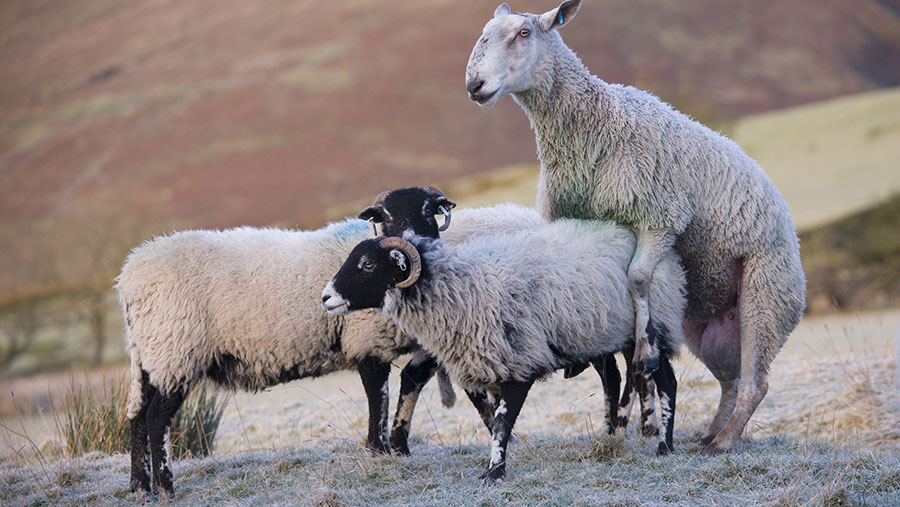6 ways to make your teaser rams work for you
 © FLPA/John Eveson/Shutterstock
© FLPA/John Eveson/Shutterstock Using teasers can be used to bring lambing forward by around a fortnight or dramatically reduce lambing periods to a week to 10 days in length.
The benefits of using teasers may include lambing earlier to catch spring markets or producing a compact lambing period to reduce staffing and labour costs.
This also helps in timing lamb vaccinations and coccidiosis treatments as lambs are closer in size and age.
See also: Guide to breeding from ewe lambs
This is according to Devon-based veterinarians Mike Glover and Liz Nabb of Torch Farm Vets, who say there are several principles and theories around using teasers.
They give six pointers from their farm experiences that have been for a successful in tightening up lambing periods.
1. Pick a fit ram to castrate
The ram must have good teeth, feet and libido and, ultimately, a good bill of health.
“Younger teasers are good as this means getting several seasons out of them,” explains Ms Nabb. “Ram lambs can be vasectomised, but their libido won’t be as good and they need to go with experienced ewes.”
2. Keep them apart
Suggested teaser timeline
- Day 0 – teaser goes in
- Day 14 – replace teaser with breeding rams
- Day 25 – remove rams from ewes
Ideally, you need to isolate ewes from all rams for several weeks beforehand – at least a mile away – so there’s no smell, sound or sight.
Mr Glover says: “Studies suggest teasers can still work effectively to give you a more compact lambing period even if you can’t achieve separation.
“You will probably find, however, that you get better results after completely separating the ewes from males for two to three weeks and preferably a month, if possible.”
3. Put them in with ewes at the optimum time
Teasers work best if the ewes aren’t fully in season so it is good if you can catch them when they are on the transition between anoestrus and oestrus. Day zero starts five-and-a-half months before you wish to start lambing.
Ms Nabb says: “Seasonality is related to breed, rather than location. There are long season breeders like Dorsets, which are fertile most of the year. Then there are Charolais ewes, which are usually cycling by July.
“Mules and Suffolks cycle from August or September time. Texels are shorter season breeders and don’t usually get going until September onwards, and hill breeds are also usually quite short in their season.
“Long season breeders like Dorsets make the best teasers. A breed which looks different from the stock rams is also helpful to avoid confusion.”
4. Teaser-to-ewe ratio
Veterinarians advise on using teasers at ratios of one teaser for 50-100 sheep.
“It is not always possible for a farm to have as many teasers as this, but we would usually suggest a 400-head sheep flock using no fewer than four or five teasers to achieve a good effect,” says Mr Glover.
5. Remove teasers after a fortnight
The teaser should go in with the ewes on day zero for 14 days to get the ewes cycling before the stock ram replaces the teaser on day 14 at a ratio of one per 20-30 ewes.
Ms Nabb says: “The ram effect works by the teaser releasing a pheromone, which sets the ewes into a period of estrous. Make sure the rams are fertile before use to avoid returns.
“Teasers prompt the ewe’s pituitary gland to release luteinizing hormone, which makes a follicle mature to produce an egg. The egg disappears down the fallopian tube leaving a small crater behind, which fills with progesterone.
“This is called the corpus luteum and it stays for around two weeks until prostaglandin is produced, which ends the heat and the process (the luteal phase), then repeats itself.”
6. Tup between day 14 and 25 to catch differences in cycling
All sheep need at least one normal cycle before producing their first fertile heat of the season and around half will need two cycles before becoming fertile on the third.
“The split is due to physiological variation between different ewes,” explains Ms Nabb. “You don’t know which sheep are which but some need a short cycle before their first normal-length cycle, with the third cycle then making them fertile.
“Around half the flock will start their breeding season by having a normal 17-day estrous cycle, with the second cycle making them fertile. The other 40-50% will have two cycles (one short five-day cycle and a normal cycle) before becoming fertile on the third cycle.”
